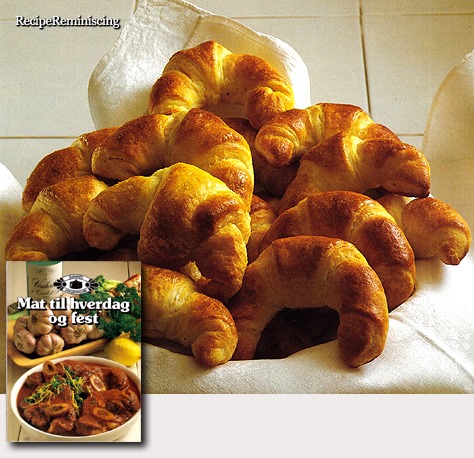A classic pie recipe found on frukt.no
Delicious hot apple pie. With ready-made puff pastry sheets, it’s easy
to make a delicious apple pie of the delicious “grandma” variety.
A classic pie recipe found on frukt.no
Delicious hot apple pie. With ready-made puff pastry sheets, it’s easy
to make a delicious apple pie of the delicious “grandma” variety.
A personal favourite from “Varme Småretter”
(Hot Snacks) published by Gyldendal in 1991
This was often part of the Saturday evening family gathering at our cabin outside Oslo when I was a child. This recipe is exactly the same as my mother used and I still use, though I’m a bit heavier on the curry than she was. I am so fond of this that I know the recipe by heart- Ted
This is a very popular starter for big parties. The safest is to order the shells in good time in a bakery or in the grocery store. Filled shells can be served as hot dishes on a smörgåsbord or as a separate dish with friend gatherings. Calculate two shells for each serving. The fish puddings can be exchanged with tiny fish balls and the prawns with crayfish tails.
An afternoon tea classic found on chatelaine.com
Tradition has it that the layering in Bakewell tart (in this case, a sweet, buttery filling over huckleberry jam) was a mistake that caught on. Served with whipped cream and fresh berries, this classic British confection is a proper dessert, or perfect for high tea. This dish is part of the pub fare on the menu at many pubs.
A delicious chicken recipe found in “Fjærfe På Menyen” (Poultry On The Menu) published by Den Norske Bokklubben in 1984
Baked chicken breast wrapped in puff pastry with a creamy typically French mustard sauce, served in a simple manner with asparagus beans and garnished with parsley. Sounds great to me – Ted
A classic French recipe found in “Mat for Hverdag og Fest”
(Food for Everydays and Parties) published by
Hjemmets kokebokklubb in 1884
The Kipferl, ancestor of the croissant, has been documented in Austria going back at least as far as the 13th century, in various shapes. The Kipferl can be made plain or with nuts or other fillings (some consider the rugelach a form of Kipferl).
The birth of the croissant itself–that is, its adaptation from the plainer form of Kipferl, before the invention of viennoiserie–can be dated to at least 1839 (some say 1838), when an Austrian artillery officer, August Zang, founded a Viennese bakery (“Boulangerie Viennoise”) at 92, rue de Richelieu in Paris. This bakery, which served Viennese specialities including the Kipferl and the Vienna loaf, quickly became popular and inspired French imitators (and the concept, if not the term, of viennoiserie, a 20th-century term for supposedly Vienna-style pastries). The French version of the Kipferl was named for its crescent (croissant) shape and has become an identifiable shape across the world.
Alan Davidson, editor of the Oxford Companion to Food, found no printed recipe for the present-day croissant in any French recipe book before the early 20th century; the earliest French reference to a croissant he found was among the “fantasy or luxury breads” in Payen’s Des substances alimentaires, 1853. However, early recipes for non-laminated croissants can be found in the 19th century and at least one reference to croissants as an established French bread appeared as early as 1850.
Zang himself returned to Austria in 1848 to become a press magnate, but the bakery remained popular for some time afterwards, and was mentioned in several works of the time: “This same M. Zank [sic]…founded around 1830 [sic], in Paris, the famous Boulangerie viennoise”. Several sources praise this bakery’s products: “Paris is of exquisite delicacy; and, in particular, the succulent products of the Boulangerie Viennoise”; “which seemed to us as fine as if it came from the Viennese bakery on the rue de Richelieu”.
 By 1869, the croissant was well established enough to be mentioned as a breakfast staple, and in 1872 Charles Dickens wrote (in his periodical All the Year Round) of “the workman’s pain de ménage and the soldier’s pain de munition, to the dainty croissant on the boudoir table”
By 1869, the croissant was well established enough to be mentioned as a breakfast staple, and in 1872 Charles Dickens wrote (in his periodical All the Year Round) of “the workman’s pain de ménage and the soldier’s pain de munition, to the dainty croissant on the boudoir table”
The puff pastry technique which now characterizes the croissant was already mentioned in the late 17th century, when La Varenne’s Le Cuisinier françois gave a recipe for it in the 1680, and possibly earlier, editions. It was typically used not on its own but for shells holding other ingredients (as in a vol-au-vent). It does not appear to be mentioned in relation to the croissant until the 20th century.